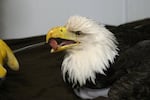Among the hundreds of animals treated by the Wildlife Center of the North Coast, located in Astoria, Oregon, it’s rare for staff to receive groups of eagles in a short period of time.
But in the span of a week earlier this month, that’s what happened. Staff at the center received three bald eagles, an unusually high amount. The nonprofit animal hospital treats injured and sick wildlife on Oregon’s north coast.

Staff feed a bald eagle at the Wildlife Center of the North Coast in Astoria, Ore. The bird had elevated levels of lead in its system.
Courtesy of Wildlife Center of the North Coast
All three initially arrived for other injuries: one was found emaciated, one was hit by a car near Clatskanie, a city situated about 35 miles east of Astoria, and another was found in a driveway. Two of them had elevated levels of lead in their system, according to Ginger Nealon, the Wildlife Center’s rehabilitation coordinator.
“It’s unusual for us to get three eagles at once,” Nealon said. “It’s also not uncommon for eagles to show elevated lead levels, unfortunately.”
Nealon said eagles suffering from lead poisoning have a lethargic, droopy appearance. Eagles typically resist being handled by humans, but those with lead in their systems often are too tired.
Two of the birds have died from other injuries and illnesses. The final one that was found in a driveway is on the road to recovery. If its lead levels decline, it could be released in the wild, Nealon said.
Related: Nearly half of US bald eagles suffer lead poisoning
High lead levels are fairly common for scavenging species like eagles, which often ingest lead pellets in the carcasses of large animals, like deer, killed by humans. About one-third of all eagles test positive for acute levels of lead, according to the American Eagle Foundation.
Nealon said it’s difficult to know if their eagles are in any way connected or ingested lead in similar places. Neither had been shot.
The Wildlife Center is seeking donations, since testing and treating lead poisoning for each eagle can cost thousands of dollars.
“It involves giving the eagle a lot of medications, twice a day,” Nealon said. “So that can be pretty stressful.”
